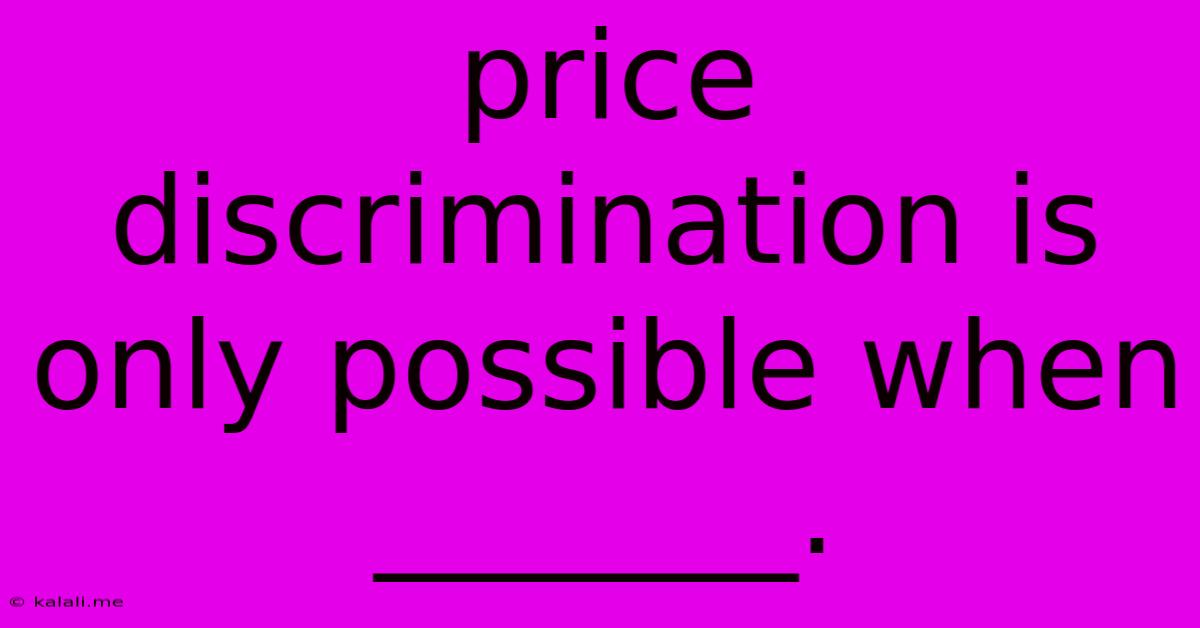Price Discrimination Is Only Possible When _______.
Kalali
Jun 15, 2025 · 3 min read

Table of Contents
Price Discrimination is Only Possible When... Market Segmentation is Achievable
Price discrimination, the practice of charging different prices for the same product or service to different customers, is a fascinating economic concept. It's a powerful tool for businesses aiming to maximize profits, but its successful implementation hinges on a crucial condition: the ability to effectively segment the market. This article delves into the specific requirements for successful price discrimination, exploring the complexities of identifying and targeting different customer groups.
This article will cover:
- The definition and types of price discrimination.
- The necessary conditions for successful price discrimination.
- Examples of successful price discrimination strategies.
- The challenges and ethical considerations associated with price discrimination.
Understanding Price Discrimination
Price discrimination isn't simply offering discounts; it's about strategically charging different prices based on varying customer willingness to pay. There are three main degrees of price discrimination:
- First-degree (perfect) price discrimination: Charging each customer the maximum price they are willing to pay. This is theoretically the most profitable but practically very difficult to achieve.
- Second-degree price discrimination: Charging different prices based on the quantity consumed. Examples include bulk discounts or tiered pricing plans.
- Third-degree price discrimination: Charging different prices to different groups of customers. This is the most common type and often involves segmenting customers based on demographics, location, or time of purchase.
The Crucial Condition: Market Segmentation
The core requirement for successful price discrimination is the ability to effectively segment the market. This means dividing the customer base into distinct groups with different price sensitivities. Without this segmentation, businesses risk undermining their pricing strategy. Consider these key factors:
- Identifiable groups: The business needs to be able to reliably identify customers belonging to different segments. This could be based on observable characteristics (age, location) or inferred from behavior (past purchases, online browsing history).
- Different price elasticities of demand: Each segment must exhibit a different responsiveness to price changes. A segment with inelastic demand (less sensitive to price) will be charged a higher price than a segment with elastic demand (more sensitive to price).
- Prevention of arbitrage: The business must prevent customers from reselling the product or service at a lower price to other segments, undermining the price differences. This often requires controlling distribution channels and limiting product transferability.
Examples of Successful Price Discrimination
Several industries successfully employ price discrimination:
- Airlines: Offering different fares based on booking time, flexibility, and route.
- Movie theaters: Charging different prices for matinee and evening showings.
- Software companies: Offering different licensing tiers with varying features and prices.
- Subscription services: Providing different levels of access at different price points (e.g., Spotify, Netflix).
Challenges and Ethical Considerations
While price discrimination can be profitable, it's not without challenges:
- Identifying and targeting segments: Accurately identifying and targeting segments can be complex and expensive.
- Legal and regulatory constraints: Some forms of price discrimination are illegal, particularly those that are deemed anti-competitive.
- Ethical concerns: Some argue that price discrimination is unfair and exploits vulnerable customer segments.
In conclusion, price discrimination is only possible when a business can effectively segment its market into groups with differing price sensitivities, prevent arbitrage, and legally and ethically implement differentiated pricing strategies. The success of this strategy relies heavily on a deep understanding of customer behavior and market dynamics.
Latest Posts
Latest Posts
-
Which Of The Following Is Not A Primary Color
Jun 15, 2025
-
Which Of The Following Is A Characteristic Of Emotions
Jun 15, 2025
-
Sample Letter To Bank To Close Account
Jun 15, 2025
-
Examples Of Direct Current And Alternating Current
Jun 15, 2025
-
University Of Maryland Eastern Shore Gpa Requirements
Jun 15, 2025
Related Post
Thank you for visiting our website which covers about Price Discrimination Is Only Possible When _______. . We hope the information provided has been useful to you. Feel free to contact us if you have any questions or need further assistance. See you next time and don't miss to bookmark.